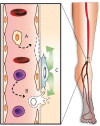Cell Therapy for Chronic Limb-Threatening Ischemia: Current Evidence and Future Directions
- PMID: 30070050
- PMCID: PMC6265636
- DOI: 10.1002/sctm.18-0025
Cell Therapy for Chronic Limb-Threatening Ischemia: Current Evidence and Future Directions
Abstract
Cell-based therapies have gained interest as a potential treatment method in cardiovascular disease in the past two decades, peripheral artery disease amongst others. Initial pre-clinical and small pilot clinical studies showed promising effects of cell therapy in peripheral artery disease and chronic limb-threatening ischemia in particular. However, these promising results were not corroborated in larger high quality blinded randomized trials. This has led to a shift of the field towards more sophisticated cell products, especially mesenchymal stromal cells. Mesenchymal stromal cells have some important benefits, making these cells ideal for regenerative medicine, e.g., potential for allogeneic application, loss of disease-mediated cell dysfunction, reduced production costs, off-the-shelf availability. Future high quality and large clinical studies have to prove the efficacy of mesenchymal stromal cells in the treatment of peripheral artery disease. Stem Cells Translational Medicine 2018;7:842-846.
© 2018 The Authors. Stem Cells Translational Medicine published by Wiley Periodicals, Inc. on behalf of AlphaMed Press.
Figures

References
-
- Norgren L, Hiatt WR, Dormandy JA et al. Inter‐society consensus for the management of peripheral arterial disease (TASC II). J Vasc Surg 2007;45:S5–S67. - PubMed
-
- Barshes NR, Chamber JD, Cohen J et al. Cost‐effectiveness in the contemporary management of critical limb ischemia with tissue loss. J Vasc Surg 2012. Oct;56:1015–1024. - PubMed
-
- Farber A, Eberhardt RT. The current state of critical limb ischemia: A systematic review. JAMA Surg 2016;151:1070–1077. - PubMed
-
- TASC Steering Committee , Jaff MR, White CJ et al. An update on methods for revascularization and expansion of the TASC lesion classification to include below‐the‐knee arteries: A supplement to the inter‐society consensus for the management of peripheral arterial disease (TASC II). J Endovasc Ther 2015;22:663–677. - PubMed
-
- Setacci C, de Donato G, Teraa M et al. Chapter IV: Treatment of critical limb ischaemia. Eur J Vasc Endovasc Surg 2011;42:S43–S59. - PubMed
MeSH terms
LinkOut - more resources
Full Text Sources
Other Literature Sources
Miscellaneous

